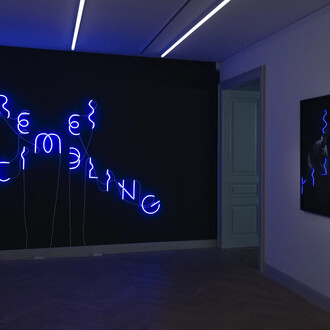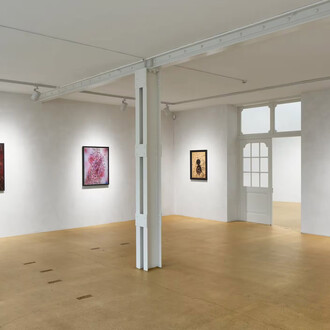Rochelle Feinstein’s subjects are no less than freedom of opinion, feminism, racism, the AIDS crisis and Donald Trump. Over nearly thirty years the New York artist, a long-time professor of painting and printmaking at Yale University, has created a body of work that reveals itself as politically caustic yet densely humorous.
Her painting, which the viewer generally encounters in a forceful blast, deals consistently with the cultural and political connections of artistic production, transferring everyday individual and collective feelings into a language of abstraction. For Feinstein, painting is an anti-hierarchical endeavour to answer the question of what the medium can mean today, societally and culturally, without being limited by traditional forms. Her greatest critic, or, to put it better, her closest observer, is Rochelle Feinstein herself. Through an unswerving challenge to the meaning of painting in the world today she gives a voice back to painting: a voice that remains on the pulse, and engages with the viewer in a direct, natural and anything but elitist manner.
Language is an important element of this artistic discourse. Feinstein’s work is repeatedly defined by speech bubbles, (self)-critical comments and significant key words from individual or collective vocabularies. “Whatever the source of these words and phrases, each is a form of communication, or miscommunication,” comments the artist in a conversation. “Commonplace speech, colloquialisms, clichés that are lacking in emotion. If I’m lucky, they often stage my paintings. I’ve been collecting these enigmas, informally at first, since the 1990s, and in the last six or so years, as what I term flash cards. However, these are one-sided; the question is the phrase, the answer comes through the painting.”
The solo exhibition at the Kunsthaus Baselland, which was developed in collaboration by Ines Goldbach and the artist, follows Feinstein’s major retrospective that, until recently, toured Europe and will conclude this autumn in New York. This new exhibition concentrates particularly on current works: works made by Feinstein over the past two years, in part during a residency in Rome. Maps play a central part here, and not just due to the fact that the artist is always on the move. “Historical maps drew my attention quite recently,” she remarks. “Before and after the 2016 US election, perhaps like many others, I must have looked at maps at least a dozen times a day. While boundaries remained stable, the metrics changed as often. Each work from the last two years began with my selecting and engaging with familiar forms: heart, calendar, monochrome, trophy, etc. Bleep and Plein Air I, II are the only two works that use maps as a ‘form thought’ or foundation… Yes, as you say, maps help us to ‘navigate or orient ourselves’. Since 2016 it’s become increasingly impossible to do that. These paintings are maps of disorientation, obfuscation and deletion.”
Perhaps this is the key to Rochelle Feinstein’s vibrant work, which can raise the pulse if viewers follow where the artist would take them: painting that does not pacify, but is an event, an experience of the world.












